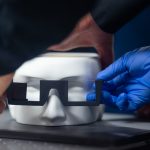Could Stanford's latest AR glasses render our smartphones obsolete? Here's why the future might be worn over your eyes, not held in your hands. Stanford University's Computational Imaging Lab has introduced a holographic glasses prototype that might just redefine the future of augmented reality (AR). Their innovation hinges on a revolutionary nanophotonic metasurface waveguide … [Read more...] about Seeing is Believing: Stanford’s AR Leap Towards Holographic Horizons
AR / VR
Explore the world of virtual and augmented reality. Discover the latest advancements in VR and AR technology and how they are being used in various industries. Learn how to get started with VR and AR and find resources for further learning.
Can Virtual Reality Help People Feel Engaged With the Climate Crisis?
A tech giant's electronic waste floats to the bottom of the ocean, several fish species consume its metal and chemical remnants and nearby flora wither in its wake. Knowing this pollution is happening is different from seeing it firsthand. Would the impact of climate change be more tangible if virtual reality (VR) helped people visualize it? This development could inspire a new … [Read more...] about Can Virtual Reality Help People Feel Engaged With the Climate Crisis?
Why the 5G Era Will Revolutionize Television and Entertainment as we Know it
The entertainment industry is at a crossroads in 2024. Legacy TV broadcasting services have long succumbed to the acceleration of new technologies and now our satellite and cable-based viewing habits have finally lost the battle for popularity against streaming platforms in the US. With 5G around the corner, entertainment will never be the same again. This streaming … [Read more...] about Why the 5G Era Will Revolutionize Television and Entertainment as we Know it
What Is Real User Monitoring and Why It Matters?
In today's digital age, businesses rely heavily on their online presence to attract and retain customers. With the increasing complexity of websites and applications, it has become crucial for businesses to understand how users interact with their digital platforms. This is where Real User Monitoring (RUM) comes into play. RUM is a powerful tool that provides businesses with … [Read more...] about What Is Real User Monitoring and Why It Matters?
AI-Driven Insights: Big Data Empowering Dynamic Scheduling Tools
The marriage of artificial intelligence (AI) and big data has brought about a revolution in scheduling tools, transforming them from mere digital calendars into powerful tools that can adapt to dynamic environments. With the increasing amount of data being generated every day, traditional scheduling tools are struggling to keep up with the complexity and unpredictability of … [Read more...] about AI-Driven Insights: Big Data Empowering Dynamic Scheduling Tools
What is virtual reality (VR)?
VR is a computer-generated simulation of a three-dimensional environment that can be interacted with in a seemingly real or physical way. VR is typically experienced using a headset and hand controllers, which track the user’s movements and allow them to interact with the virtual environment.
VR can be used for a variety of purposes, such as gaming, training, and entertainment. It has the potential to create immersive and interactive experiences that are not possible in the real world.
What is augmented reality (AR)?
AR is a technology that superimposes digital information or graphics onto the real world, creating a layered experience. AR can be experienced through devices such as smartphones, tablets, or specialized glasses, which use cameras and sensors to track the user’s movements and display the digital content on top of the real world.
AR is used for a variety of applications, including gaming, education, and advertising. It has the potential to enhance the real world with interactive and informative digital content.
What are the differences between VR and AR?
VR creates a fully immersive, computer-generated environment, while AR enhances the real world with digital information. VR requires specialized equipment, such as a headset and hand controllers, to experience, while AR can be accessed through everyday devices such as smartphones.
VR is typically used for fully immersive experiences, while AR is more commonly used for overlaying digital content onto the real world.
What are some examples of VR and AR?
Examples of VR include video games, educational simulations, and virtual tours. Examples of AR include Pokemon Go, Snapchat filters, and interactive museum exhibits. These are just a few examples of the many possible applications of VR and AR, which are being used in a wide range of industries and contexts.
How can I learn more about VR and AR?
There are many resources available for learning about VR and AR on Datafloq, including online courses, books, and industry events. Online courses, such as those offered by Coursera, edX, and Udacity, can provide a comprehensive overview of the technologies and their applications.
There are also many books on VR and AR that cover various aspects of the technologies and their uses. Attending industry events, such as conferences or meetups, can also be a great way to learn about VR and AR and network with others in the field. It is also possible to try out VR and AR experiences at specialized centers or through demos provided by companies that develop VR and AR technology. This can be a great way to get a firsthand experience of what these technologies are capable of.






